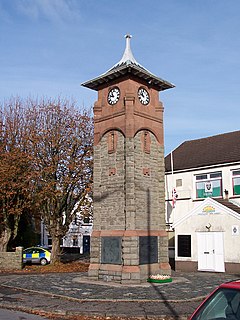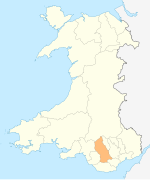Hirwaun
| Hirwaun | |
|---|---|
 Hirwaun War Memorial | |
Location withinRhondda Cynon Taf | |
| Population | 4,990 |
| OS grid reference | SN966055 |
| Principal area | |
| Preserved county | |
| Country | Wales |
| Sovereign state | United Kingdom |
| Post town | ABERDARE |
| Postcode district | CF44 |
| Dialling code | 01685 |
| Police | South Wales |
| Fire | South Wales |
| Ambulance | Welsh |
| UK Parliament | |
| Senedd Cymru – Welsh Parliament | |
Hirwaun(/ˈhɪərwaɪn/,locally/ˈhɜːrwɪn/;[1]Welsh pronunciation:[ˈhɪrwai̯n]) is a village andcommunityat the north end of theCynon Valleyin theCounty BoroughofRhondda Cynon Taf,South Wales.It is 4 miles (6 km) NW of the town ofAberdare,and comes under the Aberdarepost town.At the2001 census,Hirwaun had a population of 4,851.[2]increasing at the 2011 census to 4,990.[3]The village is on theHeads of the ValleysRoad and at the southern edge of theBrecon Beacons National Park.
Etymology[edit]
Hirwaun(also formerly spelled as Hirwain, Herwain and Hyrwen) derives from two commonWelsh toponyms"hir" meaning long and "gwaun" (mutated to "waun" ) meaning moorland.
Writing in 1887,Thomas Morganstated that the correct name isHirwaun Gwrgant,meaning Gwrgan's "Waun". This name comes from its association with Gwrgan ab Ithel (1033 - 1070), aking of Morgannwgwho is said to have freely given a portion of the waun (named "Y Waun Hir" ) to his poor subjects and all other Welshmen for raising corn, and the breeding of sheep and cattle. Morgan further states that in olden times the waun extended from Blaengwrach (near Rhydgroes) toMountain Ash,a length of nearly ten miles.[4]
History and background[edit]
Hirwaun has an industrial background centred around the Hirwaun Ironworks. After the ironworks closed, coal mining continued, and was a major employer until the second half of the 20th century.
The Crawshay family were powerful, almost all-powerful in the production of steel, and the Hirwaun Ironworks had produced cannons used onHMS Victory.The family owned a large portion of Hirwaun and even used their own currency, the "Hirwaun Guinea", to pay employees, a form oftruck systemwhich stopped employees travelling to Cardiff or spending their money outside the controlled economy of the village.[5]
Following theminers' strike,the only deep coal mine left in Wales was the nearbyTower Colliery,whichBritish Coalshut in 1994. The Colliery was then bought-out by its workers, after which it reopened in 1995. It finally closed in 2008.
Industry[edit]
Anthony Bacon started iron production atCyfarthfain 1765. His business partner, Francis Homfray, ran the works during the Napoleonic Wars. The finished product was transported to the port of Cardiff by mules and pack-horses.[6]The works later passed through a succession of owners before being purchased in 1819 byWilliam Crawshayof Cyfarthfa. Crawshay expanded the works, leading to a population influx into the locality.[7]By 1830, nearly 900 men were employed at the Hirwaun works, and in the same year the first railway steam engine seen in the locality began to operate from the works.[6]The ironworks remained in family hands until its closure in 1859. The ironworks'blast furnacesrequired coke, which spurred an increase in localcoal mining.
Government[edit]
Hirwaun had its own seat on Glamorgan County Council from 1889. The first member elected was SirWilliam Thomas Lewis,later Lord Merthyr. Hirwaun was also part of theAberdare Urban District Councilarea.
Until 2022 Hirwaun was the name of anelectoral wardtoRhondda Cynon Taf County Borough Council,electing one county borough councillor. Following a boundary review, it was merged with neighbouring Rhigos to become 'Hirwaun, Penderyn and Rhigos', electing two councillors.
Gallery[edit]
-
Macmillan Cancer Support Charity Walk withRyan JonesHirwaun to Abercynon, April 26, 2008
Religion[edit]
St Lleurwg's Church[edit]
Saint Lleurwg'sparish churchis in the centre of the village, in the ecclesiastical parish of Hirwaun. It was opened byAlfred Ollivant,Bishop of Llandaffin July 1858. The sister church in the parish, inPenywaun,is dedicated toSaint Winefred.
Saint Therese Of Lisieux Church[edit]
The first Roman Catholic Church was established in the Mission Room overlooking the Iron Works (built 1880 demolished in 1969). The present day church was built in 1965.[8]
Nonconformist chapels[edit]
There were a number of nonconformist chapels in Hirwaun village, most dating from its early days as an industrial settlement when large numbers of people arrived from rural Wales. The chapels includedRamoth(Baptist),Nebo(Congregationalist) andSoar(Wesleyan Methodist).
During the1904-05 Religious Revival,Evan Roberts,the main instigator of the movement, visited the village.[9]
Architecture[edit]
Unlike mostSouth Wales Coalfieldvillages, Hirwaun has an array of differentarchitecturalhousing styles, often cheek-by-jowl in small blocks. This is due to developments to satisfy different needs at different times, with muchgentrificationin the last few decades. So Hirwaun has a discontinuous, hotch-potch feel to it that marks it out as unusual in theSouth Wales Valleys.
The tower blocks[edit]
Hirwaun made local news in May 2004 when its two 1960s-built tower blocks were demolished bydynamitedetonation. Their demise marked the end of a major landmark in theCynon Valleyand was symptomatic of a broader failure in the design of British public housing.[10]
Hirwaun Common development[edit]
Currently[when?]the patch of green land known as Hirwaun Common is beingstrip minedagain. This was first done in the 1940s and 1950s.
Transport[edit]
The village was originally served byHirwaun railway stationon theVale of Neath Railway,which arrived in 1851. At Gelli Tarw Junction east of the station, the mainline fromNeathtoMerthyr Tydfilmet theVale of Neath Railwaybranch toAberdareand theAberdare Railway.South of the station were the goods yard and sidings which served the various industries in the area, including Hirwaun Ironworks, Tower Colliery, two brickworks, and Penderyn quarry tramway.
With theBeeching Axein 1963, the lines south to Neath and north to Merthyr and the former Aberdare Railway were all closed. Hirwaun station was demolished. The line north to Aberdare on theMerthyr LinetoCardiff Centralwas only kept open for coal traffic to Tower Colliery, which moved itscoal washeryand loading facility onto the site of the former sidings near the Rhigos industrial estate.
After the second closure of Tower in early 2008, in November 2009 the Welsh Assembly Government (WAG) askedNetwork Railto conduct a feasibility study on reopening the line to Hirwaun for passenger services.[11]After clearing the line of vegetation, Network Rail submitted its report to WAG. Currently, no decision has been made as to whether the line from Hirwaun to Aberdare will reopen. The Robertstown crossing will be a deciding factor. However, the Welsh Government have added the extension of the line to the map of theSouth Wales MetroLight Rapid Transit System, which is planned to take over the line fromCardiff Bayto Aberdare and then to Hirwaun.
Sports[edit]
Hirwaun Recreational Ground, known locally as the Welfare Ground, is the main sporting facility in the village. The ground has one soccer field, one Rugby Union field, two tennis courts (hard surface) and a bowling green. The ground has its own dedicated floodlit training area.
Rugby[edit]
Hirwaun RFC currently play rugby football in the Welsh Rugby Union League (SWALEC League) 3b South Central.
Association Football[edit]
Hirwaun has Hirwaun FC (formerly Glancynon FC) playing association football in theAberdare Valley Football Leaguepremier division.
Squash[edit]
The village has a squash team called Hirwaun Squash Federation, formed in 2012. Founded by local lads Greg Williams and Jamie Evans, they play from the local Aberdare Sports Centre and compete in the South Wales Squash Association leagues.[12][citation needed]
Notable people[edit]
- See alsoCategory:People from Hirwaun
- Gareth Evans,film director
References[edit]
- ^Wells, John C.(2008).Longman Pronunciation Dictionary(3rd ed.). Longman.ISBN978-1-4058-8118-0.
- ^Davies, John; Jenkins, Nigel (2008).The Welsh Academy Encyclopaedia of Wales.Cardiff: University of Wales Press. p. 369.ISBN978-0-7083-1953-6.
- ^"Community population 2011".Retrieved16 November2015.
- ^Morgan, Rev. Thomas (1887).Handbook of the Origins of Place-names in Wales and Monmouthshire.Merthyr Tydfil: HW Southey. p. 135.
- ^Cyfarthfa IronworksOld Merthyr Tydfil
- ^abRees.Chapels in the Valley.pp. 124–5.
- ^Jones 1964,pp. 149–50.
- ^"Saint Therese Of Lisieux".Hirwaun Historical Society.Retrieved18 July2022.
- ^"Evan Roberts at Hirwaun".Aberdare Leader.21 January 1905. p. 5.Retrieved15 October2016.
- ^"Le Corbusier - Enfant terrible of Modernist Architecture?".Pash Classics Blog.10 October 2014.Retrieved22 December2020.
- ^"Old tracks could see trains again".BBC News.6 November 2009.
- ^"Tweet".twitter.com.Retrieved22 December2020.
Sources[edit]
Books and journals[edit]
- Jones, Alan Vernon (2004).Chapels of the Cynon Valley.Cynon Valley Historical Society.ISBN0953107612.
- Jones, Ieuan Gwynedd (1964)."Dr. Thomas Price and the election of 1868 in Merthyr Tydfil: a study in nonconformist politics (Part One)"(PDF).Welsh History Review.2(2): 147–172.
- Rees, D. Ben (1975).Chapels in the Valley.Ffynnon Press.
Online[edit]
- Rammell, Thomas Webster (1853)."Report to the General Board of Health on a preliminary inquiry into the sewerage, drainage, and supply of water, and the sanitary condition of the inhabitants of the inhabitants of the parish of Aberdare in the county of Glamorgan".Internet Archive.General Board of Health.Retrieved13 March2017.





